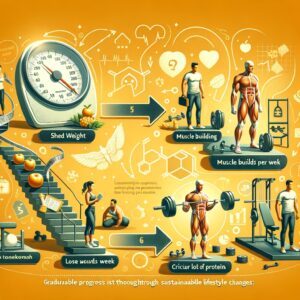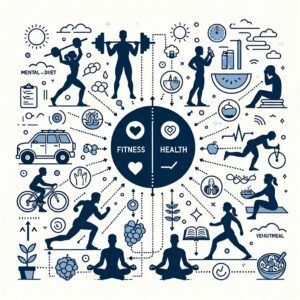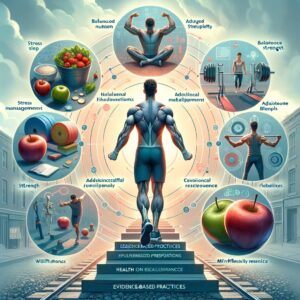In today’s fast-paced world, unlocking your best self isn’t merely about achieving peak physical performance but embracing a comprehensive lifestyle that addresses both body and mind. This guide sets the stage by defining what it means to be healthy and fit, delving into the science behind these concepts, and discussing practical strategies and myth debunking to help you find a personalized balance. It invites you on a journey of self-discovery, where evidence-based practices meet actionable insights, empowering you to establish sustainable routines that foster both physical strength and mental well-being.

Your success story is a bestseller waiting to happen! Start writing at Great Life Worldwide. Discover how it can be your publisher. Take the free tour today!
1. Defining the Concepts: What Does It Mean to Be Healthy and Fit?
In today’s dynamic environment, establishing precise definitions of health and fitness is paramount to personal development and overall performance. Health encapsulates far more than the simple absence of disease; it’s an integrated condition that encompasses physical, mental, and emotional well-being.
A healthy lifestyle is characterized by balanced nutrition, adequate rest, regular preventive medical care, and the capacity to manage stress efficiently. Fitness, in contrast, refers to the physical ability to perform various movements, demonstrating strength, endurance, flexibility, and cardiovascular resilience. Together, health and fitness form a synergistic relationship where each supports the achievement of the other.
When exploring these concepts, it’s essential to consider both quantitative metrics and qualitative experiences. Objective assessments, such as body composition measurements, cardiovascular capacity, and blood markers, offer valuable insights into one’s physical condition. Simultaneously, subjective dimensions, including mental clarity, emotional balance, and overall energy levels, provide a comprehensive perspective on well-being.
Modern approaches to health emphasize the integration of evidence-based practices, including regular exercise regimens, tailored nutrition plans, and mindfulness techniques, to reduce stress. These practices not only contribute to physical fitness but also enhance overall health by fostering resilience against daily challenges.
In professional settings, understanding health and fitness means recognizing the importance of balanced routines and proactive lifestyle choices. It involves cultivating habits that sustain energy and promote longevity, enabling individuals to meet both personal and professional demands effectively. Ultimately, clarifying what it means to be healthy and fit empowers individuals to pursue continual improvement and implement informed strategies that enhance quality of life.
Adopting this nuanced perspective enables professionals to tailor wellness programs that address diverse needs, optimize performance, and ensure sustainable progress in both personal and organizational contexts. Such an approach fosters accountability, encourages self-assessment, and ultimately leads to a more resilient and motivated workforce.

Ready to sculpt your ideal future? Chisel away at Great Life Worldwide! See how it provides the perfect tools. Free tour available -don’t let it crumble away!
2. Exploring the Balance: Can You Be Healthy Without Being Fit?
While conventional wisdom often portrays health and fitness as interdependent attributes, a closer examination reveals that the relationship between the two is complex and multifaceted. Evidence from research suggests that an individual can exhibit normal metabolic parameters and the absence of chronic disease even in the absence of high levels of physical fitness.
In this context, health is defined by factors such as balanced nutrition, appropriate sleep, stress management, and mental well-being, whereas fitness primarily relates to cardiovascular endurance, strength, and flexibility.
Although physical fitness contributes significantly to improved cardiovascular health and longevity, one can maintain a state of overall wellness even without engaging in regular high-intensity exercise routines. For example, a person with moderate physical activity levels, combined with diligent dietary habits and regular medical checkups, can achieve favorable health markers and prevent common illnesses.
However, it’s essential to acknowledge that reduced physical fitness can limit functional capacity and may ultimately lead to issues such as muscular weakness or decreased stamina. This balance underscores the notion that being “healthy” involves a broader spectrum of lifestyle choices, not solely dictated by strenuous physical activity. Professional experts emphasize the need to evaluate both parameters individually, since factors such as genetics, environmental influences, and pre-existing conditions can yield different outcomes for different individuals.
Therefore, while one may achieve a degree of health without being conventionally fit, integrating aspects of physical training can further enhance quality of life, mitigate risks, and promote resilience against health setbacks. Ultimately, the intersection of health and fitness should be viewed as a continuum, encouraging personalized approaches that respect individual capabilities and lifestyle demands.
In summary, establishing a deliberate balance between health and fitness requires ongoing assessment and adaptive strategies tailored to individual circumstances, ensuring that both domains contribute positively to overall well-being and sustainable lifestyle improvement.

Seeking the fast track to success? Accelerate at Great Life Worldwide! Learn why it’s your turbo boost. Take the free tour before the light turns red!
3. The Science Behind Health and Fitness: Understanding the Connection
Scientific research provides a valuable framework for understanding the intricate interplay between health and fitness. Evidence consistently demonstrates that optimal health is not merely the absence of disease but rather a dynamic process of sustaining bodily functions, preventing chronic conditions, and promoting overall vitality.
At a cellular level, regular physical activity initiates beneficial metabolic processes, improves cardiovascular performance, and reduces systemic inflammation. These physiological responses contribute to enhanced endurance, increased muscle strength, and improved energy regulation.
Central to this connection is the principle of homeostasis, the body’s ability to maintain a stable internal environment despite external fluctuations. Physical exercise triggers adaptive mechanisms that refine heart rate variability, optimize hormonal balance, and boost metabolic efficiency. Over time, such adaptations facilitate improved insulin sensitivity and stable blood glucose management, which are crucial for mitigating risks associated with type 2 diabetes and cardiovascular diseases.
Nutrition plays a crucial role in this scientific equation. A balanced diet supplies essential nutrients that drive energy production and support tissue repair. When combined with regular exercise, proper nutrition fosters cellular regeneration and fortifies the immune system. Additionally, emerging findings highlight the interplay between mental well-being and physical performance, where neurochemical responses from exercise enhance mood, reduce stress, and support cognitive function.
Understanding these scientific principles reinforces the notion that integrating physical activity with sound nutritional practices is fundamental for long-term health. As research continues to reveal the intricate mechanisms linking exercise, diet, and overall well-being, individuals are better equipped to harness these insights in pursuit of a healthier, more resilient lifestyle.
Scientific advancements continue to expand our understanding of personalized health solutions. Emerging studies on genetics and environmental influences further refine strategies to optimize performance and longevity. This evolving knowledge empowers professionals to design data-driven interventions that promote sustainable health and enhance overall life quality efficaciously.
4. Strategies for Achieving and Maintaining Super Health and Fitness
Achieving and maintaining exceptional health and fitness requires a structured approach that integrates both physical and mental well-being. One effective strategy is to establish clear, measurable goals that incorporate short-term milestones and long-term aspirations. This method not only provides direction but also allows for regular adjustments based on progress and feedback.
Incorporating a variety of exercise modalities, including strength training, cardiovascular workouts, and flexibility routines, ensures that the body remains challenged and balanced while reducing the risk of injury and burnout. Equally important is planning the frequency, duration, and intensity of workouts based on individual needs and capabilities.
A well-rounded nutrition plan supports the demands of an active lifestyle. Consuming nutrient-dense foods, balanced with lean proteins, complex carbohydrates, healthy fats, vitamins, and minerals, fuels the body and aids in recovery. Developing a consistent meal plan and incorporating regular hydration practices are essential steps in promoting optimal energy levels and metabolic efficiency. Additionally, periodically consulting with nutrition experts can provide personalized guidance that enhances overall fitness outcomes.
Equally crucial is prioritizing restorative practices, such as getting sufficient sleep, managing stress, and engaging in active recovery. Techniques such as mindfulness, meditation, and organized relaxation can help reduce stress levels and enable the body to recover from physical exertion, thereby preventing overtraining and burnout. Moreover, regularly monitoring progress through fitness assessments and feedback mechanisms encourages accountability and fosters a proactive mindset regarding health.
A supportive environment—whether through professional coaching, workout partners, or health communities—plays an important role in ensuring long-term commitment and progress. These networks offer motivation, share valuable insights, and provide constructive feedback, all of which contribute to refining strategies for sustainable super health and fitness.

Ready to orchestrate your success? Tune in at Great Life Worldwide! Discover how it can be your conductor. Take the free tour before the curtain falls!
5. Practical Tips: How to Keep Your Body Healthy and Fit
Maintaining a healthy and fit body requires consistency, balance, and an informed approach. Begin by establishing a structured routine that integrates both cardiovascular and strength-training exercises. Aim for at least 150 minutes of moderate aerobic activity each week, complemented with strength routines twice a week. This balanced exercise regimen promotes improved heart function, muscle tone, and overall endurance while reducing the risk of chronic illnesses.
Nutrition is fundamental; adopt a diet rich in whole foods, lean proteins, complex carbohydrates, and healthy fats. Portion control and regular meal timings help stabilize blood sugar levels and optimize metabolism. Moreover, staying hydrated throughout the day enhances cellular function and facilitates nutrient absorption, thereby contributing to overall vitality.
Prioritizing sleep and stress management is equally critical. A consistent sleep schedule, involving seven to nine hours of sleep per night, supports muscle recovery and cognitive function. Incorporating relaxation techniques, such as mindfulness and meditation, can mitigate stress levels. Regular mental rest fosters a more resilient mindset, ultimately reflected in improved physical performance and overall health.
Additionally, routine medical check-ups are crucial for the early detection and prevention of potential health issues. Monitoring key health indicators, such as blood pressure, cholesterol levels, and glucose, allows for adjustments in lifestyle or diet before concerns escalate.
Setting clear, attainable goals is a practical strategy to maintain motivation. Tracking progress through fitness journals, mobile apps, or personal assessments provides both feedback and encouragement. Lastly, engaging with a community—whether it’s a fitness group, online forum, or a professional trainer—can offer accountability and support, further inspiring a continued commitment to a healthy lifestyle. These practices, when integrated into daily routines, facilitate sustained physical health and fitness while promoting a disciplined and proactive approach to overall well-being.

Craving a recipe for success? Find the ingredients at Great Life Worldwide! Learn how it can help you cook up greatness. Free tour available!
6. Debunking Myths: Is It Possible to Be Healthy But Not Fit?
Debunking myths begins by examining the nuanced relationship between health and fitness. While it’s often assumed that these two areas inherently align, evidence suggests that they represent distinct yet overlapping domains. Health encompasses various parameters, including mental well-being, physiological balance, and metabolic status, whereas fitness primarily focuses on physical capabilities, endurance, strength, and flexibility. Consequently, individuals may exhibit favorable health indicators despite lacking rigorous physical fitness.
Research indicates that lifestyle factors such as balanced nutrition, stress management, and adequate sleep contribute significantly to one’s overall health. For instance, an individual who prioritizes a nutritious diet and mental wellness initiatives may show optimal cardiovascular function and reduced inflammation, yet might not participate in regular, structured exercise programs that enhance physical fitness. Thus, it is entirely plausible to be healthy from a biochemical and psychological standpoint without meeting the conventional markers of fitness.
Moreover, genetic predispositions and personal circumstances play critical roles in shaping one’s health. Some individuals may naturally maintain vital health metrics while leading a sedentary lifestyle due to inherent genetic factors that regulate metabolism and tissue repair. Such cases challenge the prevailing assumption that high physical fitness is an absolute prerequisite for overall health.
Nevertheless, integrating basic movement into daily routines can further enhance both physical and mental well-being without imposing excessive demands. Ultimately, appreciating the distinction between being healthy and being fit allows for a broader understanding of personal wellness, fostering realistic expectations and sustainable lifestyle choices.
It’s essential to acknowledge that the definitions of health and fitness are continually evolving. Contemporary research and expert consensus reveal that a balanced integration of mental, nutritional, and physical practices yields a more nuanced and individualized outlook. This perspective encourages ongoing dialogue between healthcare professionals and their clients, fostering a more inclusive approach to achieving well-being with evident promise.
7. Embracing a Holistic Lifestyle: Long-Term Commitment to Health and Fitness
Embracing a holistic lifestyle is a forward-thinking approach that acknowledges the interconnectedness of physical, mental, and emotional well-being. A long-term commitment to health and fitness encompasses more than just regular exercise routines and balanced nutrition. It incorporates stress management strategies, quality sleep, and mindful practices that nurture both body and mind. By recognizing that well-being is multidimensional, individuals can design more effective personalized programs that promote resilience, inspire continuous progress, and support overall vitality.
Central to this approach is the development of sustainable habits that align with one’s personal values and daily responsibilities. Establishing routines that incorporate physical activity—be it strength training, cardiovascular exercises, or flexibility workouts—alongside mindfulness practices such as meditation, yoga, or journaling can create a solid foundation for long-term success. A comprehensive strategy also includes setting realistic, measurable goals that allow for gradual advancements rather than drastic changes, reducing the likelihood of burnout.
Additionally, embracing a holistic lifestyle often involves cultivating positive social interactions and engaging in community involvement. Whether through group fitness sessions, wellness workshops, or simple acts of kindness, social support reinforces self-discipline and encourages accountability. Furthermore, regular health evaluations and consultations with professionals help tailor a regimen that adapts to evolving needs, ensuring that progress remains aligned with one’s life circumstances.
Overall, long-term commitment is essential to achieving lasting health and fitness. This mindset promotes continuous learning, adaptation, and self-care, resulting in a dynamic and rewarding journey toward optimal well-being. Embracing a holistic lifestyle isn’t merely a temporary change but a lifelong decision to honor and invest in every aspect of oneself.
Maintaining this comprehensive perspective necessitates proactive planning and a clear understanding of one’s strengths and challenges. Developing a resilient mindset, supported by consistent monitoring and refinement, ensures that the pursuit of health and fitness remains both sustainable and fulfilling, requiring dedication.

Your future is a blank page! Write about your success story at Great Life Worldwide. See how it can be your co-author. Take the free tour today!
Conclusion:
As you close this guide and prepare to implement its teachings, remember that true health and fitness are a dynamic, lifelong journey. By integrating balanced nutrition, regular physical activity, mindful stress management, and restorative practices, you build a resilient foundation for a vibrant life. Embracing a holistic lifestyle means continually evolving your habits to meet personal needs and overcome obstacles. With clear, achievable goals and a commitment to self-care, you can confidently unlock your best self and enjoy enduring, comprehensive well-being.

